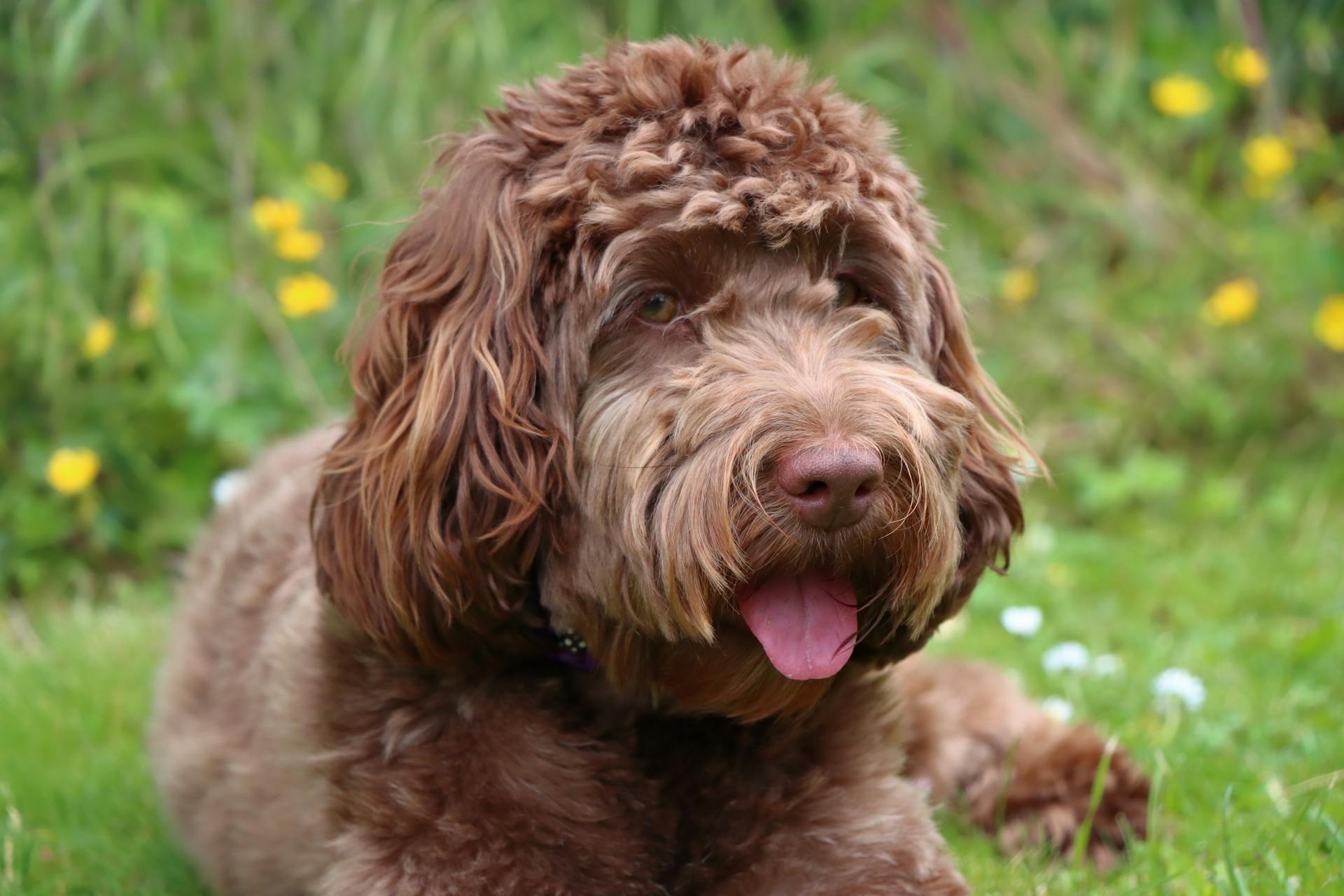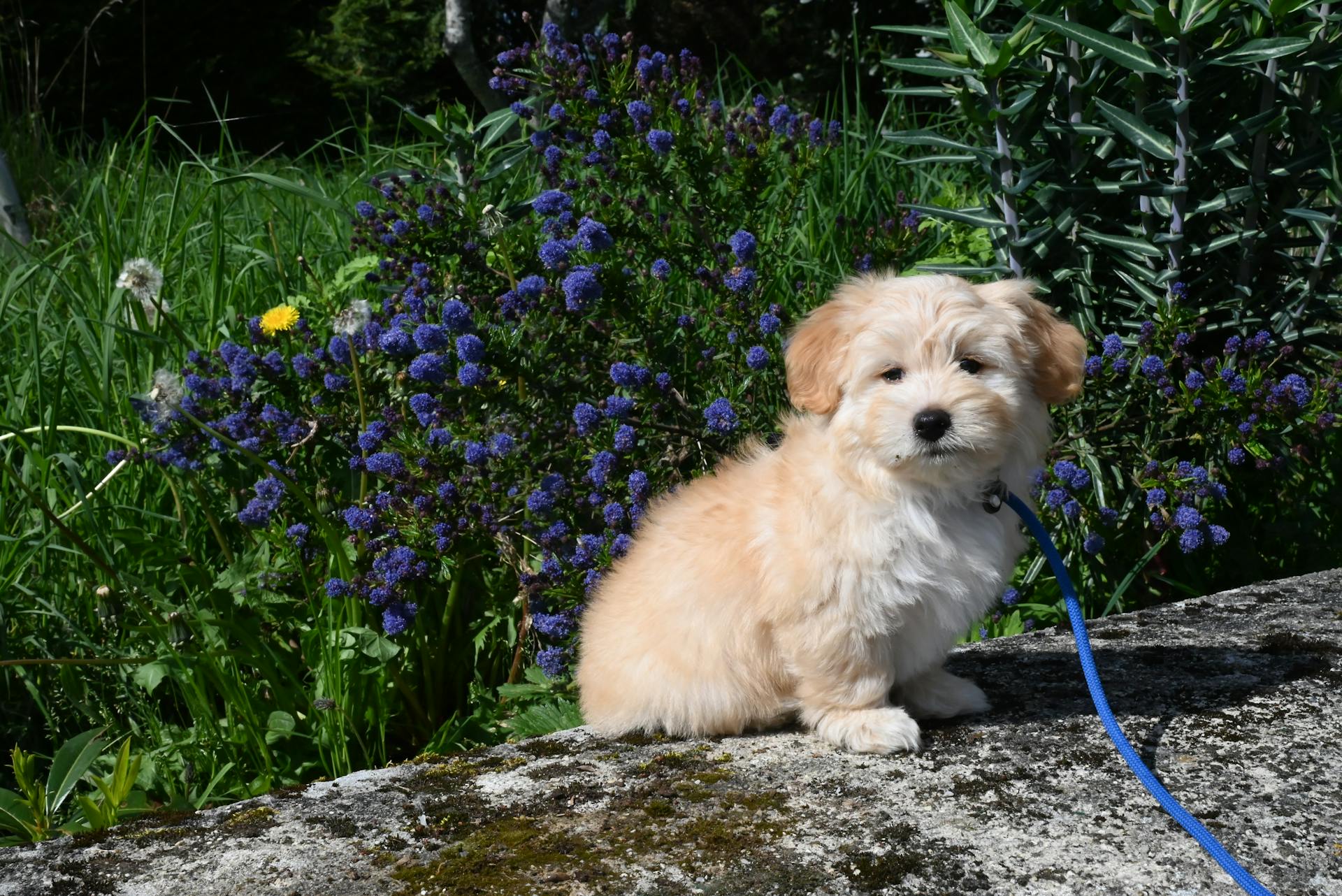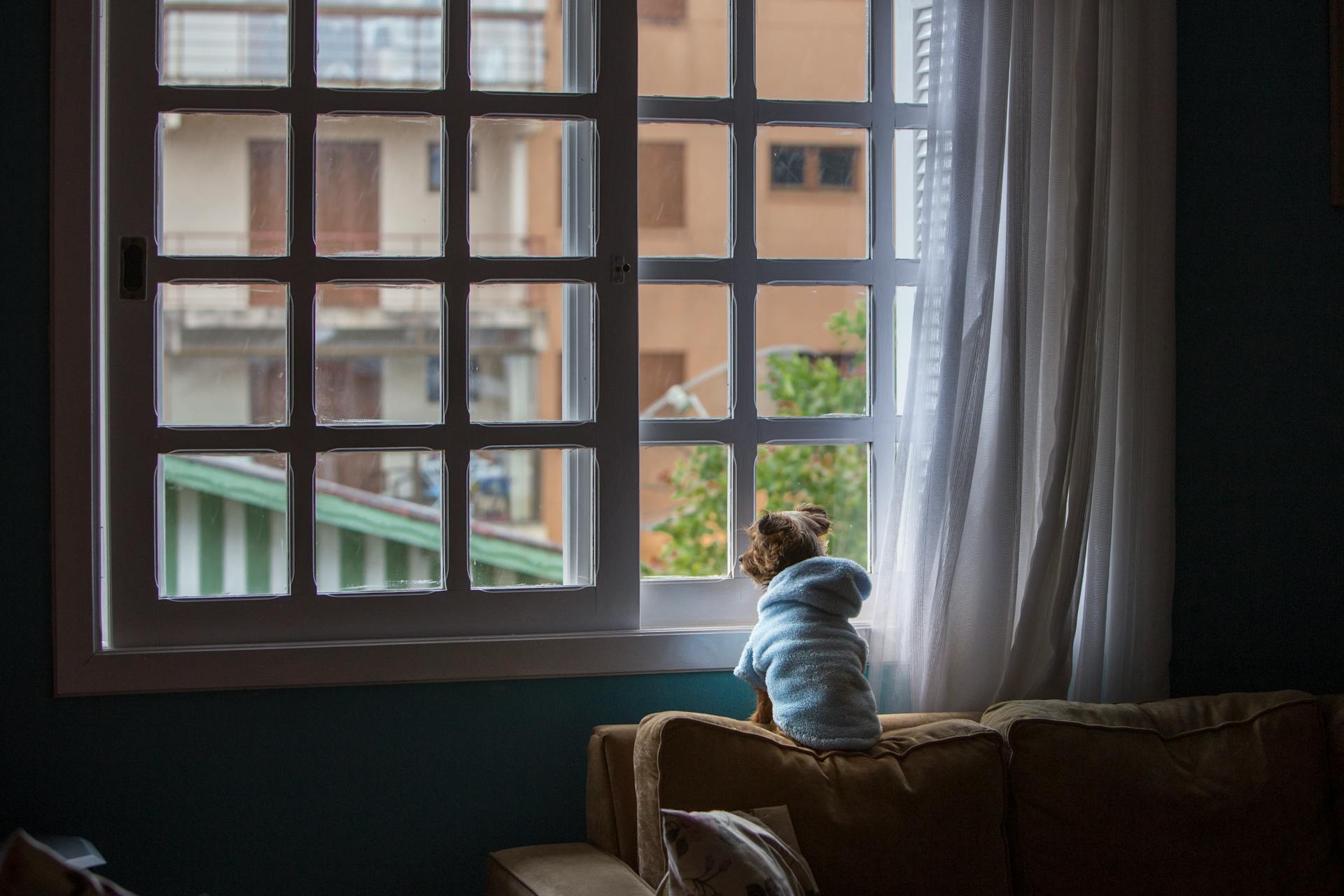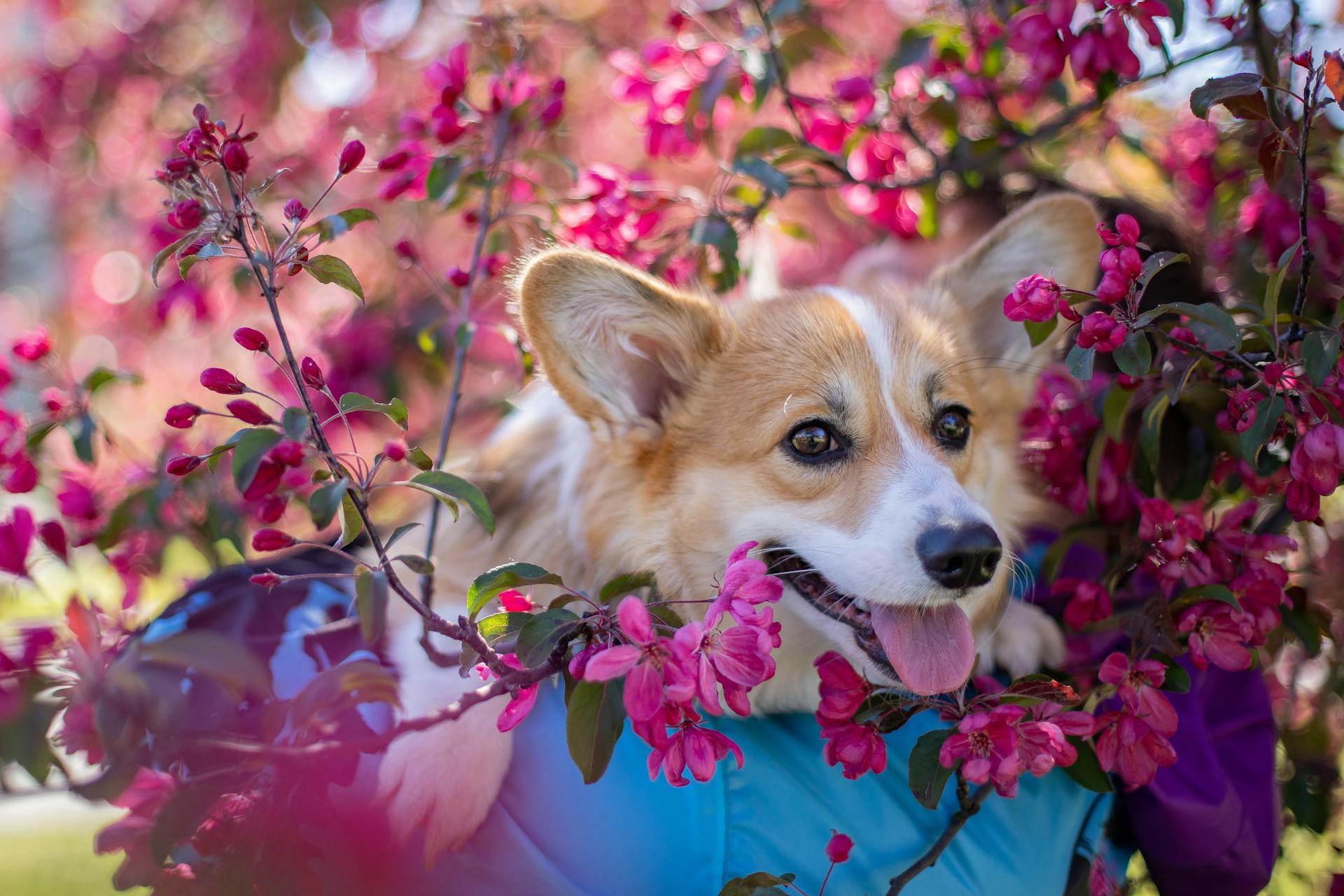
Leaving your Cockapoo alone can be a challenge, especially if you have a busy schedule. Most Cockapoos can be left alone for 4 to 6 hours a day without experiencing separation anxiety.
However, some Cockapoos may require more attention and can't be left alone for extended periods. Factors such as age, training, and breed mix can influence your Cockapoo's tolerance for alone time.
Cockapoos are social dogs and thrive on interaction, so it's essential to provide them with plenty of attention and exercise before leaving them alone.
Curious to learn more? Check out: Can I Leave My Rabbit Alone for a Week?
Understanding Separation Anxiety
Separation anxiety is a common issue that can affect any dog, regardless of age or breed. It's a serious form of isolation distress that can lead to destructive behavior, gastrointestinal symptoms, and even accidents in the house.
Some signs of separation anxiety include pacing, whining, crying, and excessive barking when left alone. A dog may also refuse to settle in their bed or crate if you're in another room or leaving the house.
Cockapoos are social animals that thrive on human interaction, which can make separation anxiety even more challenging to manage. Establishing boundaries and routines from an early age can help prevent separation anxiety, but if your dog is already exhibiting signs, it's essential to take steps to retrain them.
It's crucial to avoid leaving your dog alone for long stretches, especially in the beginning. Instead, start with short periods of time, about 10-15 minutes, and gradually increase your absences to show your dog that you will return.
To help your dog feel more comfortable alone, you can use interactive toys, puzzles, and Kongs filled with treats. A blanket or piece of clothing with your scent can also provide reassurance. A crate can be a helpful tool, but it's essential to introduce it gradually and make it a positive space for your dog.
Here are some signs of separation anxiety to look out for:
- Pacing or restlessness when left alone
- Whining or crying when you leave the house or room
- Excessive barking or destructive behavior
- Refusal to settle in their bed or crate if you're in another room or leaving the house
- Unsettled behavior at night if in a different room
- Destructive behavior when left home alone
Leaving Your Dog
You should not leave your adult dog alone for longer than four to six hours at a time. Most adult dogs can hold their bladders for more than six hours, but they really shouldn't have to.
Puppies need to eliminate way more often than adults, so it's best to limit their alone time accordingly. Some dogs, if given the opportunity, will go outside to eliminate every couple of hours.
As you get to know your dog's individual needs, you'll find that some dogs stick to their usual weekday elimination schedule, while others go out more often. The American Kennel Club recommends that puppies younger than 10 weeks cannot be left alone for more than an hour.
If possible, dogs older than 6 months should not be left alone for longer than 4 hours at a time. If this is difficult, the absolute maximum time for them to be alone is 8 hours, but this is only recommended if your dog has a way to get outside for a bathroom break.
Discover more: Can Birds Be Left Alone for a Week?
Here's a rough guide to help you gauge how long you can leave your dog alone based on their age:
Remember, every dog is different, and you know your dog best. Be patient and observe their behavior to determine their individual needs.
Minimizing Time Away
Minimizing Time Away can be a challenge, but it's not impossible. You can avoid leaving your dog alone for too long by being creative and finding solutions that work for both you and your furry friend.
You can start by adjusting your work schedule to spend more time with your dog, even if it's just a few hours a day. This will help reduce the amount of time your dog spends alone.
With a little creativity, you can find ways to make your dog feel more comfortable and secure when you're not around. It can be as simple as leaving a TV or radio on to provide background noise.
A different take: Can Maltese Dogs Be Left Alone
Some people even consider hiring a dog walker or asking a trusted neighbor to check in on their dog while they're away. This can be a great option if you have a busy schedule.
You can also try to make your home more dog-friendly by providing plenty of toys and chews to keep your dog occupied. This can help distract your dog from your absence and make the time pass more quickly.
Alternative Care Options
If you can't be home to your cockapoo regularly, consider daycare and boarding options like Wagly Veterinary Hospital & Pet Campus. They offer daycare that allows dogs to socialize, enrich, learn, and rejuvenate while you're away.
You can also ask a friend, neighbor, or professional dog walker to visit your cockapoo to prevent stress. Ideally, you shouldn't leave a puppy or young dog alone for more than 2 hours until they've been with you for 6 months.
Using an ADAPTIL Calm Home Diffuser can also help calm and relax your cockapoo when they're home alone. This clinically proven solution creates a reassuring environment until you return and can also aid with training and faster learning.
Additional reading: Ferret Home
Daycare and Boarding
If you can't get home to your dog regularly throughout the day, there are alternative care options available. Wagly Veterinary Hospital & Pet Campus offers daycare and boarding options to help.
Dogs can socialize, enrich, learn, and rejuvenate in Wagly's daycare. Whether you need short or long-term care, they have options for you.
Pet Sitter
Hiring a pet sitter can be a great alternative to boarding your dog. You can ask a friend, neighbour, or even a professional dog walker to pay your pup a visit.
Leaving a puppy or young dog alone for too long can be stressful, so it's best to keep visits short at first. Ideally, you should never leave a puppy or young dog alone for more than 2 hours until they've been with you for 6 months.
A pet sitter can let your pup out for a toilet break, which is essential for their training. This can help prevent accidents and make the training process faster.
You can also consider using an ADAPTIL Calm Home Diffuser to support your pup when they're home alone. This can help create a reassuring environment until you return.
Sources
- https://www.petplan.co.uk/pet-information/dog/breed/cockapoo/
- https://www.whole-dog-journal.com/care/how-long-is-too-long-to-leave-a-dog-alone/
- https://www.wagly.com/blog-how-long-can-you-leave-a-dog-alone/
- https://www.adaptil.co.uk/blogs/news/when-can-i-start-leaving-my-dog-home-alone
- https://www.dogster.com/dog-breeds/do-cockapoos-get-separation-anxiety
Featured Images: pexels.com


